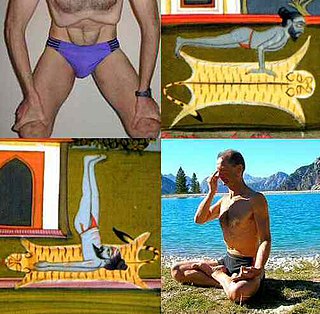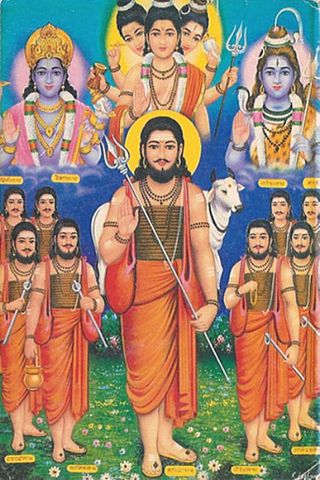Meditation is a practice in which an individual uses a technique to train attention and awareness and detach from reflexive, "discursive thinking," achieving a mentally clear and emotionally calm and stable state, while not judging the meditation process itself.

Yoga is a group of physical, mental, and spiritual practices or disciplines which originated in ancient India and aim to control (yoke) and still the mind, recognizing a detached witness-consciousness untouched by the mind (Chitta) and mundane suffering (Duḥkha). There is a wide variety of schools of yoga, practices, and goals in Hinduism, Buddhism, and Jainism, and traditional and modern yoga is practiced worldwide.

Kundalini yoga derives from kundalini, defined in tantra as energy that lies within the body, frequently at the navel or the base of the spine. In normative tantric systems, kundalini is considered to be dormant until it is activated and channeled upward through the central channel in a process of spiritual perfection. Other schools, such as Kashmir Shaivism, teach that there are multiple kundalini energies in different parts of the body which are active and do not require awakening. Kundalini is believed by adherents to be power associated with the divine feminine, Shakti. Kundalini yoga as a school of yoga is influenced by Shaktism and Tantra schools of Hinduism. It derives its name through a focus on awakening kundalini energy through regular practice of mantra, tantra, yantra, yoga, laya, haṭha, meditation, or even spontaneously (sahaja).

Hatha yoga is a branch of yoga that uses physical techniques to try to preserve and channel vital force or energy. The Sanskrit word हठ haṭha literally means "force", alluding to a system of physical techniques. Some hatha yoga style techniques can be traced back at least to the 1st-century CE, in texts such as the Hindu Sanskrit epics and Buddhism's Pali canon. The oldest dated text so far found to describe hatha yoga, the 11th-century Amṛtasiddhi, comes from a tantric Buddhist milieu. The oldest texts to use the terminology of hatha are also Vajrayana Buddhist. Hindu hatha yoga texts appear from the 11th century onward.

Yoga nidra or yogic sleep in modern usage is a state of consciousness between waking and sleeping, typically induced by a guided meditation.

The Art of Living Foundation is a volunteer-based, humanitarian and educational non-governmental organization (NGO). It was founded in 1981 by Ravi Shankar. The Art of Living Foundation has centers in 180 countries.

Dhyāna in Hinduism means contemplation and meditation. Dhyana is taken up in Yoga practices, and is a means to samadhi and self-knowledge.

Kabir Panth is a Sant Mat denomination and philosophy based on the teachings of the 15th century saint and poet, Kabir. It is based on devotion to him as one guru as a means to salvation.The adherents of Kabir Panth are from many religious backgrounds as Kabir never advocated change of religions but highlighted their limitations. According to some scholars, this tradition belong to Vaishnavism with universalist leanings. In respect of Kabir, his followers celebrate Kabir Jayanti.

The psychological and physiological effects of meditation have been studied. In recent years, studies of meditation have increasingly involved the use of modern instruments, such as functional magnetic resonance imaging and electroencephalography, which are able to observe brain physiology and neural activity in living subjects, either during the act of meditation itself or before and after meditation. Correlations can thus be established between meditative practices and brain structure or function.

Sri Siddharameshwar Maharaj (1888–1936) was a guru in the Inchagiri Sampradaya founded by his guru Bhausaheb Maharaj, a branch of the Navnath Sampradaya, the 'Nine Masters' tradition in India. His disciples included Nath teachers Nisargadatta Maharaj, Ranjit Maharaj, Kaadsiddheshwar, and Ganapatrao Maharaj Kannur.

Bhagirath Prasad Tripathi, better known as Vagish Shastri, was an Indian Sanskrit grammarian, linguist, tantra and yogi. In 2018, Government of India awarded him the fourth highest civilian award Padma Shri for his work in the field of literature and education.
Mahamahopadhyaya Sir Gaṅgānāth Jhā was a scholar of Sanskrit, Indian philosophy and Buddhist philosophy.

Rakesh Jhaveri, also known as Pujya Gurudevshri Rakeshji, is a spiritual leader, mystic, scholar of Jainism, author and orator from India. Spiritually inclined from a young age, he is a follower of Shrimad Rajchandra, a Jain spiritual teacher. He completed doctoral studies on Shrimad's work Atmasiddhi. He founded Shrimad Rajchandra Mission, Dharampur which supports spiritual and social activities.

Swami Nigamananda Paramahansa was an Indian yogi, guru and mystic in Eastern India. He is associated with the Shakta tradition and a spiritual master of vedanta, tantra, yoga and prema or bhakti. His followers referred him as Thakura.

I. K. Taimni was a professor of chemistry at the Allahabad University in India, and an influential scholar in the fields of Yoga and Indian philosophy. He was a leader of the Theosophical Society. Taimni authored a number of books on Eastern Philosophy, including a modern interpretation of Patanjali's Yoga Sutras.

The Inchagiri Sampradaya, also known as Nimbargi Sampradaya, is a lineage of Hindu Navnath and Lingayat teachers from Maharashtra and Karnataka, which was started by Bhausaheb Maharaj. It is inspired by Sant Mat teachers as Namdev, Raidas and Kabir. The Inchagiri Sampradaya has become well known throughout the western world due to the popularity of Nisargadatta Maharaj.

Bhausaheb Maharaj was the founder of the Inchegeri Sampradaya, to which the well-known Indian guru Nisargadatta Maharaj belonged.

Brahma Abadhuta Sri Guru Dayanidhi Paramahansa was an Indian sadguru, yogi, mystic and a Hindu spiritual leader well known in India. He was associated with the shakti school and viewed as a perfect spiritual master of gyan, yoga and prema or bhakti. His followers idealized him as their worshipped and beloved thakura (ठाकुर).

Modern yoga gurus are people widely acknowledged to be gurus of modern yoga in any of its forms, whether religious or not. The role implies being well-known and having a large following; in contrast to the old guru-shishya tradition, the modern guru-follower relationship is not secretive, not exclusive, and does not necessarily involve a tradition. Many such gurus, but not all, teach a form of yoga as exercise; others teach forms which are more devotional or meditational; many teach a combination. Some have been affected by scandals of various kinds.

















